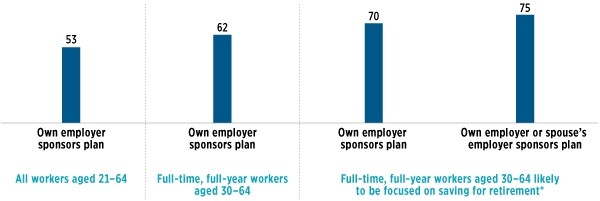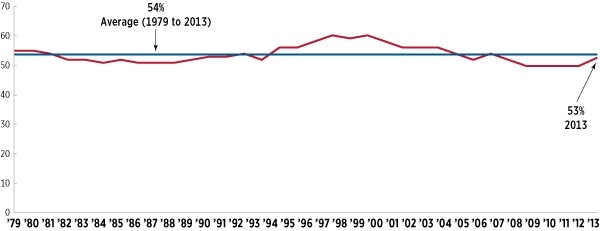News Release
ICI Study Examines Who Gets Retirement Plans
Study Illustrates Link Between Savings Goals and Access to Retirement Plans
Washington, DC, October 2, 2014 - An updated study released today by the Investment Company Institute finds that most workers who are likely to have the ability to save and to be focused primarily on saving for retirement have access to an employer-provided retirement plan. In Who Gets Retirement Plans and Why, 2013, ICI uses the most recent data on pension coverage to update its analysis of the employee characteristics that make some employers more likely to offer, and some workers more likely to seek, compensation packages that include retirement benefits.
Study Illustrates Link Between Savings Goals and Access to Retirement Plans
The study finds a clear link between the savings goals of employees and the likelihood that they work for an employer that sponsors a retirement plan. When asked the primary reason why they save, younger and lower-income households typically said that they save to fund education, purchase a house, fund other purchases, or have emergency cash on hand, and are less likely to cite retirement as the primary reason. In contrast, older and higher-earning households are more likely to save primarily for retirement. Consistent with these savings preferences, groups of workers who are more focused on saving for retirement are also much more likely to work for an employer that offers a plan.
Link Between Savings Goals and Retirement Plan Coverage
Percentage of private-sector wage and salary workers with access to employer-sponsored retirement plans, 2013

*Full-time, full-year workers who earn $45,000 or more and are aged 30 to 64, or earn $25,000 to $44,999 and are aged 45 to 64. Among full-time, full-year workers aged 35 to 44, $25,000 represents the top earnings of the 20th percentile of annual earnings and $45,000 represents the top earnings for the 50th percentile of annual earnings.
Source: ICI tabulations of March 2014 Current Population Survey
As the chart shows, among all private-sector wage and salary workers aged 21 to 64, 53 percent work for an employer that sponsors a retirement plan. Among full-time, full-year workers aged 30 to 64, 62 percent work for an employer that sponsors a retirement plan. If the analysis is narrowed further to those groups of workers most likely to be focused on saving for retirement—workers aged 30 and older with at least moderate levels of earnings, and all but the lowest-earning workers aged 45 and older—then 70 percent work for an employer that sponsors a plan, while 75 percent have access to a retirement plan through either their own employer or their spouse’s employer. The 93 percent participation rate among those within this group with access to a retirement plan further demonstrates their strong interest in retirement savings.
“It’s well known that about half of America’s workers are covered by an employer-sponsored retirement plan, but less is known about who is in that half, and why,” said Peter Brady, ICI senior economist and a coauthor of the study. “Policy discussions surrounding retirement often focus on this statistic, but the percentage of the workforce with a retirement plan today is an underestimate of the percentage of workers who will reach retirement having accrued employer-provided retirement benefits. Many more workers will have access to a plan at some point in their career than is indicated by taking a snapshot of coverage at any single point in time.”
The study provides a comprehensive analysis of the private pension system to provide facts for policymakers, employers, and the financial services industry to consider as they work to increase retirement plan coverage. In addition, it is important to recognize that employer plans are only one component of the U.S. retirement system, providing resources to supplement Social Security benefits. For workers with low lifetime income, Social Security provides the bulk of retirement resources, making it vital that Social Security be put on sound financial footing.
Retirement Plan Coverage Higher in 2013
As part of the update to the study, ICI also released updated supplemental tables that provide extensive additional detail on pension coverage from 1979 to 2013. These data show that the portion of private-sector wage and salary workers aged 21 to 64 working for employers that sponsored retirement plans was 53 percent in 2013, up from 50 percent in 2012. Since 1979, private-sector retirement coverage has averaged 54 percent and ranged from 50 percent to 60 percent. The coverage rate had fallen below its historical average in 2008 and, in the wake of the financial crisis and recession, stood at 50 percent from 2009 to 2012. With the increase in 2013, the coverage rate is now close to its long-run average.
Share of Private-Sector Workers Covered by an Employer Plan Rose in 2013
Percentage of private-sector wage and salary workers aged 21 to 64 at employers sponsoring
retirement plans, 1979–2013

Source: ICI tabulations of March Current Population Surveys
Brady coauthored the study with Michael Bogdan, ICI associate economist. The data analyzed are from the U.S. Census Bureau and U.S. Bureau of Labor Statistics’ March 2014 Current Population Survey.
